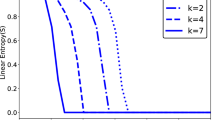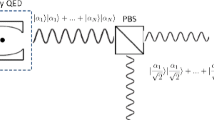Abstract
We study the mathematical properties of the excited coherent states, which are obtained through actions of a photon creation operator of the mode optical field on its corresponding coherent state, by analyzing the minimal set of Klauder’s coherent states. Using linear entropy as a measure of entanglement, we investigate in detail the entanglement generated via a beam splitter when an excited coherent state is injected on one input mode and vacuum state is injected on the other one. Finally, we examine the physical properties of the excited coherent states through the Mandel’s parameter and the Wehrl entropy and we give the correlation between these parameters and the entanglement of the output state.
Similar content being viewed by others
References
Bell J.S.: On the Einstein–Podolsky–Rosen paradox. Physics 1, 195–200 (1964)
Einstein A., Podolsky B., Rosen N.: Can quantum-mechanical description of physical reality be considered complete?. Phys. Rev. 47, 777–780 (1935)
Nielsen M.A., Chuang I.L.: Quantum Computation and Information. Cambridge University Press, Cambridge, UK (2000)
Bennett C.H., Brassard G., Crepeau C., Jozsa R., Peres A., Wootters W.K.: Teleporting an unknown quantum state via dual classical and Einstein–Podolsky–Rosen channels. Phys. Rev. Lett. 70, 1895–1899 (1993)
Agrawal P., Pati A.: Perfect teleportation and superdense coding with W states. Phys. Rev. A 74, 062320 (2006)
Yin Z.Q. et al.: Security of counterfactual quantum cryptography. Phys. Rev. A 82, 042335 (2010)
Noh T.G.: Counterfactual quantum cryptography. Phys. Rev. Lett. 103, 230501 (2009)
Morimae T.: Strong entanglement causes low gate fidelity in inaccurate one-way quantum computation. Phys. Rev. A 81, 060307 (2010)
Schaffry M. et al.: Quantum metrology with molecular ensembles. Phys. Rev. A 82, 042114 (2010)
Wootters W.K.: Entanglement of formation and concurrence. Quantum Inf. Comput. 1, 27 (2001)
Bennett C.H., Bernstein H.J., Popescu S., Schumacher B.: Concentrating partial entanglement by local operations. Phys. Rev. A 53, 2046 (1996)
Popescu S., Rohrlich D.: Thermodynamics and the measure of entanglement. Phys. Rev. A 56, R3319 (1997)
Zyczkowski K., Horodecki P., Sanpera A., Lewenstein M.: Volume of the set of separable states. Phys. Rev. A 58, 883 (1998)
Vidal G., Werner R.F.: Computable measure of entanglement. Phys. Rev. A 65, 032314 (2002)
Berrada K., El Baz M., Saif F., Hassouni Y., Mnia S.: Entanglement generation from deformed spin coherent states using a beam splitter. J. Phys. A Math. Theor. 42, 285306 (2009)
Gerry C.C., Benmoussa A.: Beam splitting and entanglement: generalized coherent states, group contraction, and the classical limit. Phys. Rev. A 71, 062319 (2005)
Tan S.M., Walls D.F., Collett M.J.: Nonlocality of a single photon. Phys. Rev. Lett. 66, 252–255 (1991)
Sanders B.C.: Entangled coherent states. Phys. Rev. A 45, 6811–6815 (1992)
Sanders B.C., Lee K.S., Kim M.S.: Optical homodyne measurements and entangled coherent states. Phys. Rev. A 52, 735–741 (1995)
Toth G., Simon C., Cirac J.I.: Entanglement detection based on interference and particle counting. Phys. Rev. A 68, 062310 (2003)
Kim M.S., Son W., Buzek V., Knight P.L.: Entanglement by a beam splitter: nonclassicality as a prerequisite for entanglement. Phys. Rev. A 65, 032323 (2002)
Rauschenbeutel A., Nogues G., Osnaghi S., Bertet P., Brune M., Raimond J.M., Haroche S.: Step-by-step engineered multiparticle entanglement. Science 288, 2024 (2000)
Zheng S.-B., Guo G.-C.: Efficient scheme for two-atom entanglement and quantum information processing in cavity QED. Phys. Rev. Lett. 85, 2392–2395 (2000)
Zhang J.S., Chen A.X., Abdel-Aty M.: Two atoms in dissipative cavities in dispersive limit: entanglement sudden death and long-lived entanglement. J. Phys. B At. Mol. Opt. Phys. 43, 025501 (2010)
Gershenfeld N., Chuang I.L.: Bulk spin-resonance quantum computation. Science 275, 350–356 (1997)
Braunstein L., Caves C.M., Jozsa R., Linden N., Popescu S., Schack R.: Separability of very noisy mixed states and implications for NMR quantum computing. Phys. Rev. Lett. 83, 1054–1057 (1999)
Ivan, J.S., Mukunda, N., Simon, R.: Generation of NPT Entanglement from Nonclassical Photon Statistics. Quant-Ph/0603255
Berrada K., El Baz M., Hassouni Y.: Generalized spin coherent states: construction and some physical properties. J. Stat. Phys. 142, 510 (2011)
Berrada K., Hassouni Y.: Maximal entanglement of bipartite spin states in the context of quantum algebra. Eur. Phys. J. D 61, 513 (2011)
Berrada K., El Baz M., Hassouni Y.: Generalized Heisenberg algebra coherent states for power-law potentials. Phys. Lett. A 375, 298 (2011)
Eleuch H.: Photon statistics of light in semiconductor microcavities. J. Phys. B 41, 055502 (2008)
Hassouni Y., Curado E.M.F., Rego-Monteiro M.A.: Construction of coherent states for physical algebraic systems. Phys. Rev. A 71, 022104 (2005)
Eleuch H., Rachid N.: Autocorrelation function of microcavity-emitting field in the non-linear regime. Eur. Phys. J. D 57, 259 (2010)
Eleuch H., Bennaceur R.: Nonlinear dissipation and the quantum noise of light in semiconductor microcavities. J. Opt. B Quantum Semiclassical Opt. 6, 189 (2004)
Glauber R.J.: Coherent and incoherent states of the radiation field. Phys. Rev. 131, 2766 (1963)
Perlomov A.M.: Coherent states for arbitrary Lie group. Commun. Math. Phys. 26, 222 (1972)
Perelomov A.: Generalized Coherent States and Their Applications. Springer, New York (1986)
Zhang W.M., Feng D.H., Gilmore R.: Coherent states, theory and some applications. Rev. Mod. Phys. 62, 867–927 (1990)
Inomata A., Kuratsuji H., Gerry C.: Path Integrals and Coherent States of SU(2) and SU(1,1). World Scientific, Singapore (1992)
Agarwal G.S., Tara K.: Nonclassical properties of states generated by the excitations on a coherent state. Phys. Rev. A 43, 492–497 (1991)
Markham D., Vedral V.: Classicality of spin-coherent states via entanglement and distinguishability. Phys. Rev. A 67, 042113 (2003)
Nielsen M.A.: Conditions for a class of entanglement transformations. Phys. Rev. Lett. 83, 436–439 (1999)
Mandel L., Wolf E.: Optical Coherence and Quantum Optics. Cambridge University Press, Cambridge (1955)
Wehrl A.: On the relation between classical and quantum-mechanical entropy. Rep. Math. Phys. 16, 353–358 (1979)
Short R., Mandel L.: Observation of sub-poissonian photon statistics. Phys. Rev. Lett. 51, 384–387 (1983)
Perina J., Hradil Z., Jurco B.: Quantum Optics and Fundamentals of Physics. Kluwer, Dordrechet (1994)
Author information
Authors and Affiliations
Corresponding author
Rights and permissions
About this article
Cite this article
Berrada, K., Abdel-Khalek, S., Eleuch, H. et al. Beam splitting and entanglement generation: excited coherent states. Quantum Inf Process 12, 69–82 (2013). https://doi.org/10.1007/s11128-011-0344-9
Received:
Accepted:
Published:
Issue Date:
DOI: https://doi.org/10.1007/s11128-011-0344-9




